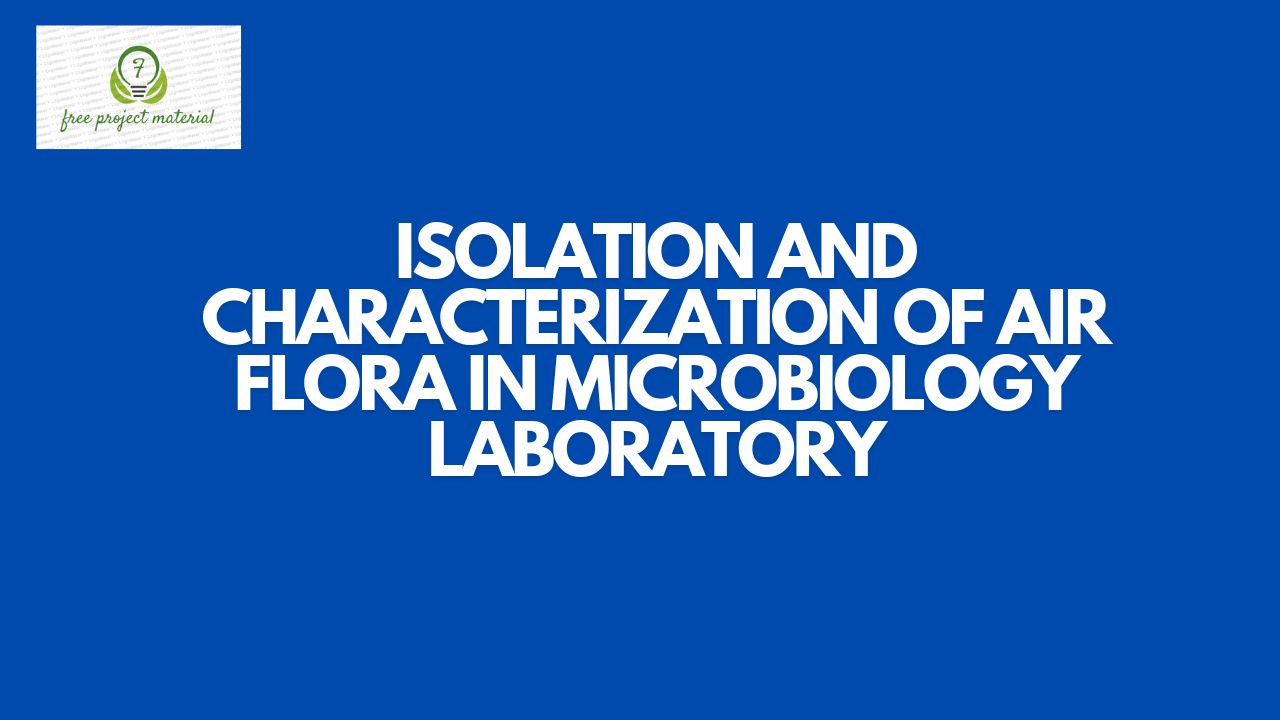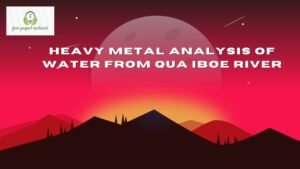ABSTRACT
The isolation and characterization of air flora in microbiology laboratory was investigated. The settle plate technique using open petri dishes containing different culture media was employed to collect sample at different time interval. Standard microbiological methods were used for the isolation and identification of bacterial and fungal isolates. The results obtained revealed that the concentration of bacteria in the study area ranged from 15 cfu/p/m2 to 60 cfu/p/m2 while that of fungi was 6 cfu/p/m2 to 25 cfu/p/m2. A total of 5 bacteria and 6 fungal species were isolated and identified with varying frequencies of occurrence. This include Escherichia sp, Corynebacterium sp, Bacillus sp, Pseudomonas sp, Staphylococcus sp, while the fungi isolated include Aspergillus sp, Absidia sp, Mucor sp, Penicillium sp, Cladosporium sp, and Alternaria sp. The bacterial isolates Bacillus sp (26.1%) and Staphylococcus sp (23.2%) were shown to be predominant airborne bacteria while Aspergillus sp (28.8%) and Penicillium sp (27.1%) were the most frequently isolated fungal species. Microorganism are present in the laboratory base on the samples exposed and the population of students in the laboratory can also increase the microbial load. It is advisable that proper hygiene condition should be maintained in the laboratory.
TABLE OF CONTENTS
Title Page – – – – – – – – – i
Certification – – – – – – – – ii
Dedication – – – – – – – – – iii
Acknowledgements – – – – – – – iv-v
Abstract – – – – – – – – – vi
Table of Contents – – – – – – – – vii-ix
CHAPTER ONE
1.1 INTRODUCTION – – – – – – 1-5
1.2 Aim and Objectives of the Study – – – – 6
1.3 Scope and Limitation of the Study – – – – 6
CHAPTER TWO
2.0 LITERATURE REVIEW
2.1 Air as an Environment of Micro Organisms – – – 7
2.2 Microorganisms Found in Air – – – – – 7-8
2.3 Adaptation of Microorganism in the Air Environment – 8-12
2.4 Biological aerosols – – – – – – 12
2.4.1 Microorganism Suspended in Air as a Colloidal System – 12-13
2.4.2 The Size of Bioaerosols – – – – – – 13-14
2.4.3 Mechanisms Protecting Lungs against bioaerosols – – 14-16
2.4.4 Survival and Spread of the Bioaerosols – – – 16
2.5 Factors Responsible for Resistance of Microorganism – 17-19
2.6 Health Hazard of Microorganism in Air – – – 19-20
2.6.1 Infectious Airborne Diseases – – – – – 20-24
2.6.2 Allergic Disease – – – – – – – 24-25
2.6.3 Poisoning – – – – – – – – 26
2.7 Basic Sources of Microorganism in Air – – – 27
2.7.1 Natural Sources – – – – – – – 27
2.7.2 Artificial Sources – – – – – – – 28
2.8 Factors Limiting Microorganism in Air – – – 29-30
CHAPTER THREE
3.0 MATERIALS AND METHODS
3.1 Materials – – – – – – – – 31
3.2 Methods – – – – – – – – 32
3.2.1 Sample Collection – – – – – – – 32
3.3 Sterilization of Materials – – – – – – 32
3.4 Preparation of Culture Media – – – – – 32-33
3.5 Enumeration of Total Bacteria and Fungi Count – – 33
3.5.1 Enumeration of Total Bacterial Count – – – 33
3.5.2 Enumeration of Total Fungal Count – – – – 33
3.6 Characterization and Identification of
Microorganism Isolated – – – – – – 34
3.6.1 Morphological Identification of Bacterial Isolates – – 34
3.6.2 Identification of Bacterial Isolates – – – – 34
3.6.3 Morphological Identification of Fungal Isolates – – 35
CHAPTER FOUR
4.0 RESULTS AND DISCUSSION
4.1 Results – – – – – – – – 36-41
4.2 Discussion – – – – – – – – 42-44
CHAPTER FIVE
5.0 CONCLUSION AND RECOMMENDATION
5.1 Conclusion – – – – – – – – 45
5.2 Recommendation – – – – – – – 45
REFERENCES
CHAPTER ONE
1.1 INTRODUCTION
Microorganisms make up most of the earth’s biomass, they are found almost in every environment, surviving in extremes of radiation, heat, pressure, salinity, cold, and darkness (Royhscid et al., 2001). The air comprises nitrogen, oxygen and carbon dioxide and also the traces of other gases, inorganic particles and particles of biological origins. Bioaerosol particles include bacteria, fungi, virus, and their spores, lichen fragments, protists (e.g. protozoa, algae and diatoms) spores and fragment of plants, pollen, small seeds as well as fecal materials. (Lacey, 2006). Airborne microorganisms carried by dust clouds can directly impact human health via pathogenesis, the exposure of sensitive individuals to cellular components and development of sensitivity (Asthma) through prolonged exposure (Griffin et al., 2007).
Atmosphere (The layer nearest to the earth) contains all major groups of microbes ranging from algae to the viruses. In addition to gases, dust particles and water vapor, air also contains microorganisms. Since air is often exposed to sunlight, it has a higher temperature and less moisture, so most of these microbial forms will die. Air current is also important in the dispersal of microorganisms as it carries them over a long distance.
The presence of microorganisms in the atmosphere was revealed by the clever experiments of spallanzani in the middle of the 18th century (Capanna, 1999) and of Pasteur at the end of the 19th century (Pasteur, 1890). Yet, the atmosphere still presents a frontier for pioneering microbiologists. Aside from classical pursuits of aerobiology (descriptions of the abundance and diversity of micro-organism in the atmosphere, of their response to the physical-chemical conditions of the atmosphere and of their dissemination), Microbes are normally found in atmosphere within 300-10,000 feet above from the land.
Fungal spores such as Alternaria, Cladosporium, Penecillium and Aspergillus have been reported to be found above 4000 feet from the land of both polar and non polar air masses. Organisms found below 500 feet is mainly in over populated area, these include spores of bacillus and clostridium ascospores of yeast and fragments of mycelium, mould, streptomycetaceae ,pollen, protozoan cysts, algae, micrococcus and corynebacterium. Air found in school and hospital or living places of the person suffering from infectious disease, have also been associated with tubercle bacilli, streptococci and pneumococci (Polymenakou, 2012).
Air is the simplest of all environments and it occurs in a single phase, gas. It is not a natural environment for the growth and reproduction of microorganisms. It does not contain necessary amount of moisture and utilizable form of nutrient. In addition to gasses, dust particles and water vapour, air also contains microorganisms. Microorganisms such as bacteria, fungi virus and their spores are almost always present in the air. The quality of indoor environment is not readily controlled and can place laboratory technicians at risk (Jaffal et al., 1997). Microorganisms are the primary sources of indoor air contamination due to the fact that enclosed spaces can confine aerosols and allow them to build up to infectious levels (Jaffal et al., 1997). Vast amount of microorganisms which can be harmful to human health is deposited in the laboratory air due to one or more factors which include; human normal flora, human activities. The sources of laboratory air micro flora could be due to many factors which include: staff normal flora, visitors, students, materials in the laboratory, also man activities like coughing, sneezing, talking, and yawning may be source of laboratory infections (Ekhaise et al., 2008). Materials such as file may also be a viable source of microorganisms in the laboratory (Burge et al., 2000).
An average human breathe 10m3 air everyday, and spend 80-95% of his or her live inoors (Docarro et al., 2003). Indoor air pollution can result in health problems and even and increase in human mortality (Cabral et al., 2003). Indoor environments contain in complex mixture of live and dead microorganisms, fragments, toxins, allergens, volatile microbial organic compounds and other chemicals.
There is a growing evidence that exposure to biological agents in the indoor environment can have adverse health effects. A review made by World Health Organization (WHO) on the number of epidemiological studies showed that, there is sufficient evidence for an association between indoor dampness-related factors and a wide range of effects on respiratory health, including asthma, development, asthma exacerbation, current asthma, respiratory infection, upper respiratory tract symptoms, sneeze, cough, dyspnea (World Health Organization, 2003; McMahon et al., 2012).
Microbiological air quality is an important criterion that must be taken into account when laboratories are designed to provide a safe environment.
The load of microorganisms in the air can be measured by using sampler method or by using simple settle plate method and by calculating the colony forming unit is per cubic meter of air (cfu/m3). Recent studies have shown that there is an increase in a number of allergic reactions to microbial spores in which the young people do constitute a large number of allergy sufferers (World Health Organization, 2003; Abed, 2014).
1.2 Aim and Objectives of the Study
The air of this research Project is to isolation and identification of air flora in microbiology laboratory. And the objective of thus research project is to:
- Isolation and Identification of air flora in microbiology laboratory.
- Compare the result of this analysis with isolation standard and with the work of other researchers.
- Make recommendation in suggestion for further studies based on the result obtained from this analysis.
1.3 Scope and Limitation of the Study
The design of this research project is to investigate, isolation and identification of air flora in microbiology laboratory.
Due to time, inadequate facilities and financial constraints. This present research was limited to isolation and identification of air flora in microbiology laboratory.


